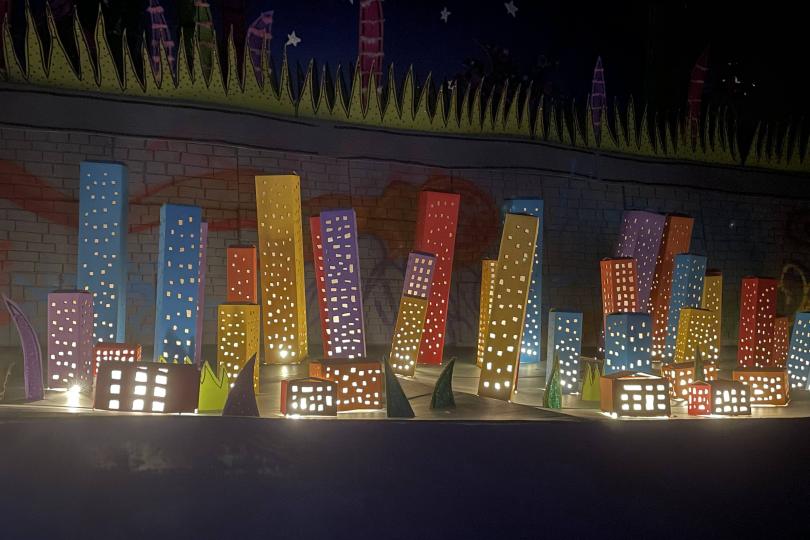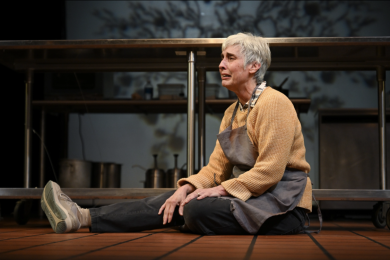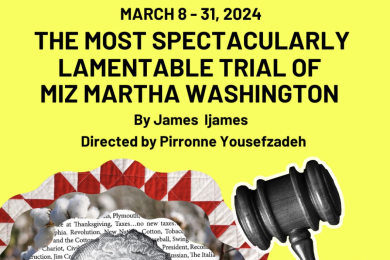You're Always Somebody To Me

I have strongly mixed feelings about puppets.
When I was a kid, I remember seeing the movie Labyrinth for the first time. Aside from the odd story and random musical numbers, I walked away from the film terrified of two things:
- David Bowie’s pants
- The fire puppets that toss their own heads around without a care in the world
One of those fears would resolve itself by the time I was 25. The other persists to this day.
When In the Heart of the Beast Theatre’s (HOBT) production of The Impact Theory of Mass Extinction came across my desk, I initially balked at the thought of puppets haunting my dreams once again. But the play description included the words “queer” and “dinosaur,” so I tucked my fears away. The Impact Theory of Mass Extinction (by Junauda Petrus-Nasah) tells the story of Demetrius and Fahari, two young black queer Minneapolis girls who feel “othered” by their current existence. After sipping a mystical concoction, the two awake in another land and another time – the land and time of the dinosaurs – just before the foreboding asteroid crashes into the planet and causes mass extinction. What are two non-dinosaurs to do? I was eager to find out, and departed for my first experience at HOBT.
According to their website, HOBT has existed in some form since 1973. They are a puppet and mask-focused theatre committed to bringing people together for the common good. I was especially pleased to read their extensive accessibility page, which includes a commitment to refrain from using strobes (to which I am particularly sensitive), ASL interpretation, and all-gender restrooms. In the “About Puppetry” section of their website, HOBT describes puppetry as “the act of transformation - of bringing something inanimate to life.” What is more inanimate in our modern lives than dinosaurs? They exist to us only as bones, after all.
Walking into HOBT, I was pleased to see that while they were not requiring patrons to be vaccinated, they were still requiring masks. I’m not quite to the point where I’m comfortable sitting in a dark room with strangers for an hour with no protection, so I happily donned my mask and entered the theatre space. The space was very dark – nearly too dark to see – save the cityscapes on either side of the house. These cityscapes, crafted of what appeared to be cardboard with hole-punched windows and lantern filling, must have taken hours upon hours of work to complete. The atmosphere pulsed with the beat of African drums, punctuated by occasional jungle sounds and childlike giggles, hinting at the story to come. Jungle vines cascade from the tall ceiling, a glittering curtain tumbled from house right, and the energy in the house was electric.
At 7:30, however, we were immediately snapped out of the delightful mood by the theatre’s interim artistic director, who was bathed in stark white light as she kindly asked for donations. Most theatres include a plea for funding in their pre-show message, but I was a bit bothered that it knocked me out of the spooky jungle mood the pre-show had worked so hard to achieve.
Once the show began, the mood returned, and the audience was transfixed. I have rarely seen (or heard) a more engaged audience at a theatre performance. They applauded feats of puppetry, feats of human movement, profound words, and moments of joy. They shouted affirmations, chanted and clapped and sang along as requested, and even got up and danced. A friend who attended with me could not tear her eyes from the stage for the entire 70-minute runtime.
I truly wish I could have been so engaged. For a theatre so focused on the art and craft of puppetry, I found the puppets to be an afterthought – almost an “Oh, we haven’t had a puppet in a while, I guess we’ll put one here?” There were also a few technical errors with the puppets that made me a bit anxious and jarred me out of the story. I want to respect the work and consideration that must go into the design and execution of each puppet, but I couldn’t help but feel like puppet-wise, we were at a preview performance instead of three days into opening weekend. The technical elements were also a bit sloppy; the sound was either too loud or nonexistent, and it cut out quite abruptly at times, even causing the actors to appear surprised. If you (like me) are sensitive to loud noise, I recommend grabbing a pair of earplugs on your way in and sitting on house right; while some of the actors will be difficult to hear over the loud underscoring, it will help when the pounding music becomes nearly unbearable.
On the positive side, the costume design (Orren Fen) was truly astonishing. The costumes were colorful and bright, with intricate headpieces that hinted at the childlike drawings of dinosaurs while still being fierce. The actors moved swiftly and elegantly in their costumes, which is quite difficult to fake – the actors must have been comfortable in their regalia, and that ease and joy shone through. This was especially true for my personal favorite performers, AJ Ashe Jaafaru (Fahari) and Demetrius McClendon aka ImagineJoy (Kairos). These performers both threw their whole personhood into their respective characters, contorting their bodies into unimaginable shapes (ImagineJoy in sky-high heels), emotion in their fingertips, sass in their voices, joy in their spirits. It was truly a delight to see queerness explode onstage in such a jubilant manner.
As for the story itself, I’ll admit I found myself a bit lost most of the time. But as the world’s whitest white person (my ancestors are German, English, and Czech), I am working on understanding that not every show is made for me. I am not the audience, I am not the intended, I am not the celebrated. I am invited, but I am not asked to understand. I am asked to honor and participate and lift up. I can do that. I think we need more art in the Twin Cities and in this world that doesn’t center white people. We need more art in the world that centers the BIPOC queer experience, like this show does. Whether I understood or enjoyed every moment of the show doesn’t matter. It’s not for me. And that alone is worth celebrating.
As the audience tumbled out of the theatre into the steaming night, my friend sighed happily and said, “That is the most Junauda show I could ever have imagined.” Ms. Petrus-Nasah is a local playwright and poet, and her love of language gleamed through the show’s dialogue. “That’s a beautiful sentiment,” I told my friend. Regardless of any opinions I may have, to be able to translate oneself so clearly to the stage is a gift, one I’m still working toward as I pen my own stories. It is a gift to have such a clear point of view, to celebrate what makes you special in this world in front of people who are nothing like you. Was this my favorite show I’ve seen this year? To be honest, no, it wasn’t. But if you support queer stories on stage, BIPOC stories on stage, female and non-binary stories on stage, puppets on stage, and joy on stage, then give this show a try. If nothing else, you might find yourself a bit challenged, a bit transported, and a bit inspired.
The Impact Theory of Mass Extinction, by Junauda Petrus-Nasah, runs at In The Heart of the Beast Theatre through June 26th, 2022. Tickets are Pay-What-You-Can (suggested donation $30), show runs 70 minutes with no intermission. For more information: https://hobt.org/impact-theory-of-mass-extinction/




